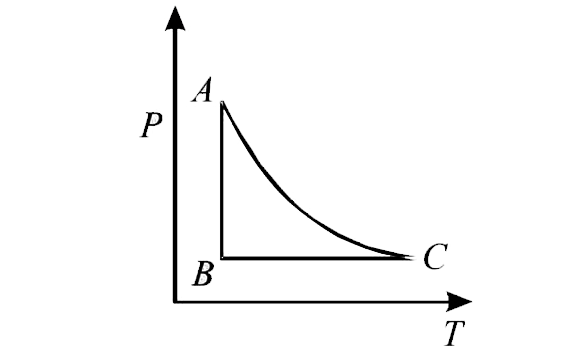Consider P−V diagram for an ideal gas shown in figure.

Out of following diagrams(figure). Which represents the T−P diagram?


A

B

C

D

Video Solution
Text Solution
The correct Answer is:C
Accoring to the question given that pV-constant Hence, we can say that the gas is going through an isothermal process.
Clearly, form the graph that between process 1 and 2 temperature is constant and the gas expands and pressure decreases i.e., P2<P1 which corresponds to diagram (iii).
|
Topper's Solved these Questions
- KINETIC THEORY OF GASESBOOK - NARAYNACHAPTER - KINETIC THEORY OF GASESEXERCISE - LEVEL-V
10 Videos
- KINETIC THEORY OF GASESBOOK - NARAYNACHAPTER - KINETIC THEORY OF GASESEXERCISE - LEVEL-VI
10 Videos
- KINETIC THEORY OF GASESBOOK - NARAYNACHAPTER - KINETIC THEORY OF GASESEXERCISE - LEVEL-3(C.W)
13 Videos
- GRAVITATIONBOOK - NARAYNACHAPTER - GRAVITATIONEXERCISE - EXERCISE -IV
40 Videos
- LAW OF MOTIONBOOK - NARAYNACHAPTER - LAW OF MOTIONEXERCISE - EXERCISE - IV
35 Videos
Similar Questions
Knowledge Check
The P-V diagram for an ideal gas is shown in figure.

Out of the following diagrams which one represents the T-P diagram ?A B
B C
C D
D
Consider p-V diagram for an ideal gas shown in figure.

Out of the following diagrams, which figure represents the T−p diagram ?
(i) A(iv)B(ii)C(iii)D(i)
A(iv)B(ii)C(iii)D(i)In P−V diagram shown below,
 AAB represents adiabatic process.BAB represents isothermal process.CAB represents isobaric process.DAB represents isochoric process.
AAB represents adiabatic process.BAB represents isothermal process.CAB represents isobaric process.DAB represents isochoric process.
P−V diagram of an ideal gas is as shown in figure. Work done by the gas in process ABCD is

View SolutionWhich of the following diagrams (figure) depicts ideal gas behaviour?
View SolutionThe PT diagram for an ideal gas is shown in the figure, where AC is an adiabatic process, find the corresponding PV diagram.

View SolutionA cyclic process ABCD is shown in VT diagram for an ideal gas. Which of the following diagram represents the same process ?

View SolutionFor the diagram given for an ideal gas, out of the following which one correctly represent the diagram?

View Solution
